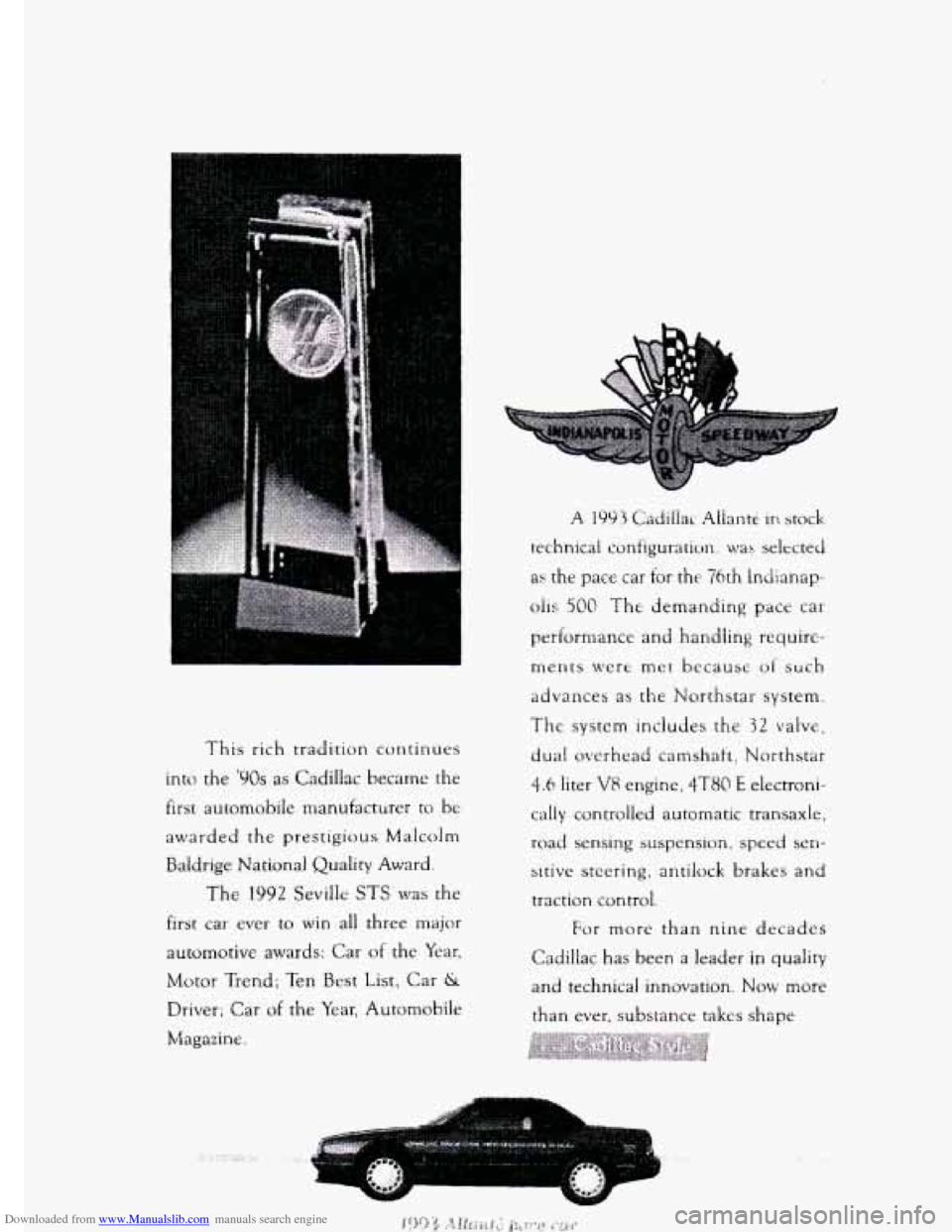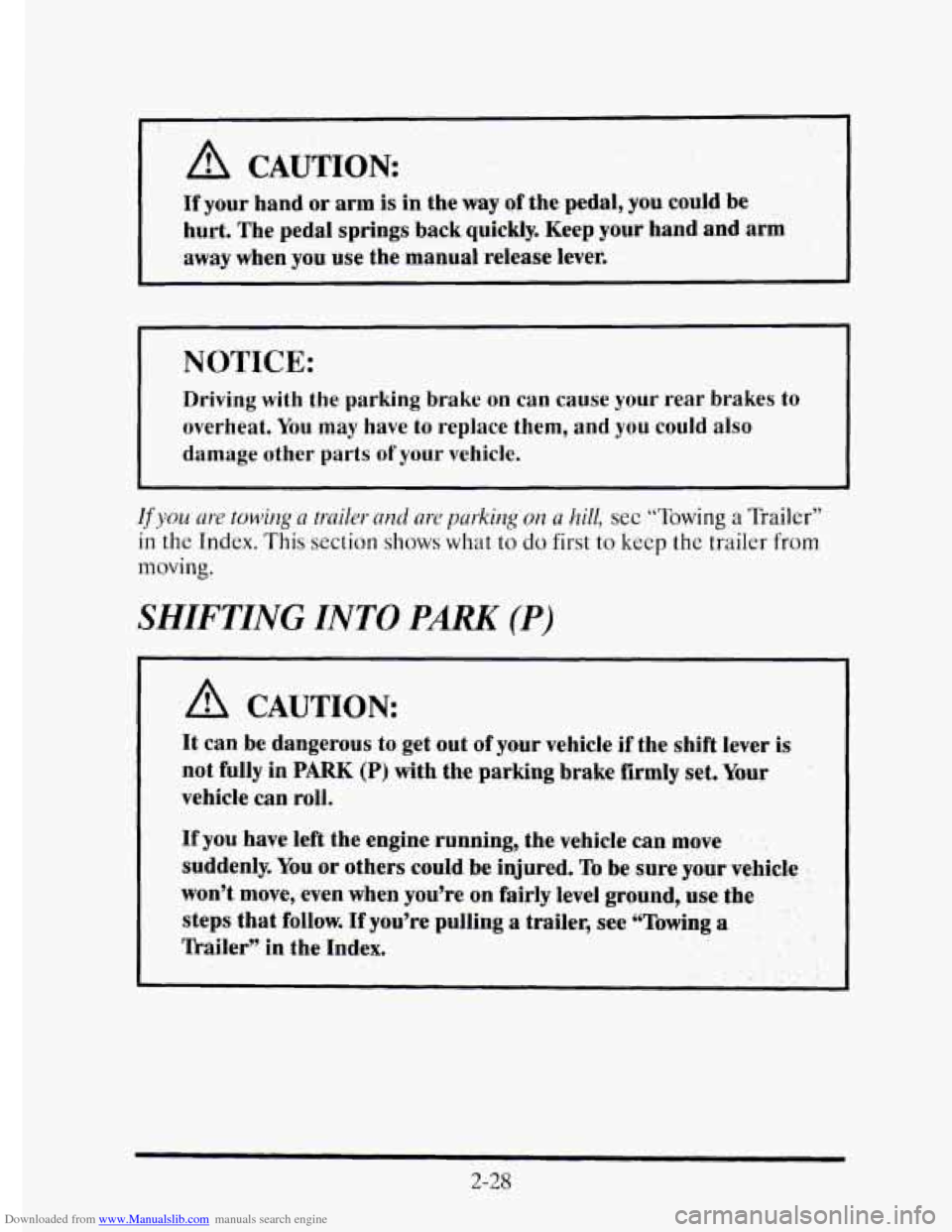Page 9 of 395

Downloaded from www.Manualslib.com manuals search engine This rich tradition continues
into
the '90s as Cadillac became the
first automobile trnnufacturer to be
awarded the prestigious Malcolm
Baldrige National Quality Award.
The 1992 Seville STS was the
iirst car' ever to win all three major
automotive awards: Car
of the Year,
Motor Trend; Ten Best List, Car ck
Driver; Car of the Year, Automobile
Magazine.
A 1993 Cadillac Ahanti in stock.
technical configuration.
wax selected
as the pace car for the 76th Inilianap-,
dis 500 The demanding pace car
performance and handling require-
menes were mer becausc of such
advances as the Northstar system.
The system includes the 32 valve,
dual ovcrhead camshaft, Northstar
4,.6 liter V8 engine, 4T80 E electroni--
cally controlled automatic transaxle,
road sensing
suspension, speed sen-
sltive steering, antilock brakes and
traction control.
For more than nine decades
Cadillac
has been a leader in quality
and technical innovation. Now more
than ever, substance takes
shape
, is:. -... :. , - .:;: i!
Page 18 of 395
Downloaded from www.Manualslib.com manuals search engine These symbols are used on warning and indicator lights:
1- I
I -1 BRAKE I I
ENGINE COOLANT
TEMPERATURE RADIATOR
COOLANT
1 CHARGING
93
I
ENGINE OIL
TEMPERATURE I ANTILOCK BRAKE
ENGINE
OIL
PRESSURE
Here are some other symbols you may see:
-
-
RADIO VOLUME
A
i
U
RADIO SELECTOR FUSE A! R CONDITIONING I
E’ u -
SPEAKER I LIGHTER
TRUNK RELEASE HORN
I
Vii
Page 89 of 395

Downloaded from www.Manualslib.com manuals search engine If you’re ever driving and you get the PASS-KEY MALFUNCTION
message
you will be able to restart your engine if you turn it off. Your
PASS-Key% system, however, is not working properly and must be
serviced by your Cadillac dealer. Your vchicle is not protected by the
PASS-K~Y~II system.
If you lose or damage a PASS-Key‘II ignition ke , see your Cadillac
dealer or
a locksmith who can service PASS-Key I1 to have a new key
made.
J
NOTICE:
Your modern Cadillac doesn’t need an elaborate “break-in.” But
it will perform better in the long run if you follow these
guidelines:
Don’t drive at any one speed -- fast or slow -- for the first
500 miles (804 km). Don’t make full-throttle starts.
0 Avoid making hard stops for the first 200 miles (322 km) or
so. During this t.ime your new brake linings aren’t yet broken
in. Hard stops with new linings can mean premature wear
and earlier replacement. Follow this “breaking-in” guideline
every time you get new brake linings.
0 Don’t tow a trailer during “break-in.” See “Towing a Trailer”
in the Index for more information.
2- 18
Page 95 of 395

Downloaded from www.Manualslib.com manuals search engine Ensure the shift lever is fully in PARK (P) range before starting the
engine. Your Cadillac has
a brake-transaxle shift interlock. You have to
fully apply your regular brakes befure you can shift from PARK (P) when
when the ignition key is
in the RUN position. If you cannot shift out of
PARK (P), ease pressure on the shift lever -- push the shift lever all the
way into PARK (P) and release the shift lever button
on the floor shift
console models as you maintain brake application. Then move the shift
lever into the gear you wish. (Press the shift lever button before moving
the shift lever
on floor shift console models.) See “Shifting Out of
PARK (P)” in this section.
REVERSE (R): Use this gear to back up.
NOTICE:
Shifting to REVERSE (R) while your vehicle is moving forward
could damage
your transaxle. Shift to REVERSE (R) only after
your vehicle
has stopped.
Also use this gear to rock your vehicle back and forth to get out of snow,
ice or sand without damaging your transaxle. See “If You’re Stuck in
Sand,
Mud, Ice or Snow” in the Index for additional information.
NEUTRAL, (N): In this position, your engine doesn’t connect with the
wheels.
To restart when you’re already moving, use NEUTRAL (N) only.
Also, use NEUTRAL (N) when your vehicle is being towed.
2-24
1
1
a
Page 97 of 395

Downloaded from www.Manualslib.com manuals search engine SECOND (2): This position gives you more power. You can use
SECOND (2) on hills. It can help control your speed as you go down
steep mountain roads, but then you would also want to use your brakes
off and on.
NOTICE:
Don’t drive in SECOND (2) for more than five miles (8 km), or
at speeds over 55 mph (88 km/h), otherwise you can damage
your transaxle.
Use AUTOMATIC OVERDRIVE (@) or
THIRD (3) as much as possible.
Don’t shift into
SECOND (2) unless you are going siower man
65 mph (105 km/h), or you can damage your engine.
FIRST
(1): This position gives you even more power than SECOND (2).
You can use it on very steep hills, or in deep snow or mud. (If the shift
lever is put
in FIRST (I), the transaxle won’t shift into FIRST (1) until
the vehicle is going slowly enough.)
NOTICE:
If your front wheels can’t rotate, don’t try to drive. This might
happen
if you were stuck in very deep sand or mud or were up
against a solid object. You could damage your transaxle.
Also,
if you stop when going uphill, don’t hold your vehicle there
with only the accelerator pedal. This could cause overheating
and damage the transaxle. Use your brakes to
hold your vehicle
in position on a
hill.
2-26
Page 98 of 395
Downloaded from www.Manualslib.com manuals search engine -
PMNG BRAKE
To set the parking brake, hold the regular brake pedal down with your
right
foot. Push down the parking brake pedal with your left foot. If the
ignition
is on, the brake system warning light will come on.
When you move out
of PARK (P) or NEUTRAL (N), if your engine is
running, your parking brake should release.
If it doesn’t, you have a
parking brake problem and should have
it fixed. In the meantime, you can
manually release your parking brake as shown by the illustration below.
Pull
on the manual
release lever which
is located
on the
driver’s side under
the instrument panel
and above the parking
brake.
2-27
Page 99 of 395

Downloaded from www.Manualslib.com manuals search engine A, CAUTION:
If your hand or arm is in the way of the pedal, you could be
hurt.
The pedal springs back quickly. Keep your hand and arm
away when
you use the manual release lever.
I NOTICE:
Driving with the parking brake on can cause your rear brakes to
overheat. You may have to replace them, and you could also
damage other parts
of your vehicle.
If you are towirg u truiler and are parking on a hill, see “Towing a Trailer”
in the Index. This section slmws what to do first to kecp the trailer from
moving.
SHIFTING INTO PARK (P)
A CAUTION:
It can be dangerous to get out of your vehicle if the shift lever is
not fully in PARK (P) with the parking brake firmly set. Your
vehicle can roll.
If you have left the engine running, the vehicle can move ’’
suddenly. You or others could be injured. To be sure your vehicle
won’t
move, even when you’re on fairly level ground, use the
steps that follow.
If you’re pulling a trailer, see “Towing a
ll-ailer” in the Index.
.. ...
2-28
Page 100 of 395
Downloaded from www.Manualslib.com manuals search engine Steering Column Ship Lever
1. Turn the ignition key to the OFF or RUN position.
2. Hold the brake pedal down with your right foot.
3. Move the shift lever into the PARK (P) position like this:
~ Pull the lever
toward you.
Move the lever up
as far as
it will go.
4. With your right foot still holding the brake pedal down, set the parking
5. Move the ignition key to LOCK.
6. Remove the key and take it with you. If you can walk away from your
brake.
vehicle with
the ignition key
in your hand, your vehicle is in PARK (P).
2-29